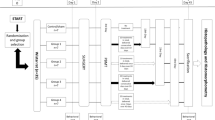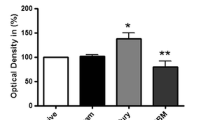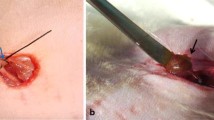Abstract.
Inferior alveolar nerve (IAN) damage can occur in trauma, cyst enucleation, sagittal split osteotomy or third molar removal, and the consequences are a loss of sensation to the mandibular teeth, gingiva and lower lip. Because of its anatomical position in a bony canal, IAN suture is rarely evoked. The aim of this study was to demonstrate the reality of IAN regeneration by using electrophysiological and histological methods after experimental section and suture of this nerve in rabbits. Nine adult female animals were used for the experiments. Six months after section and suturing using 10.0 nylon with a conventional technique, electrical stimulation of the nerve was performed to record electrophysiological activity. Each rabbit was its own reference. In each case, an action potential was recorded after microsurgical repair and definitively suppressed by section of the nerve. Morphometric analysis showed a decrease in the number of nerve fibers in the operated nerve versus the control nerve. The histological study showed an increase in nerve fibers with a cross-sectional area of 19–36 and 37–73 µm2 and a decrease in the smaller fibers (2–4 and 5–7 µm2). This preliminary study confirms the possibility of nerve regeneration in rabbits 6 months after section and conventional suturing. The French version of this article is available in the form of electronic supplementary material and can be obtained by using the Springer Link server located at http://dx.doi.org/10.1007/s00276-002-0068-8.
Résumé.
Les lésions du nerf alvéolaire inférieur (NAI) peuvent survenir en cas de traumatisme, d'énucléation de kyste, d'ostéotomie sagittale ou d'avulsion de troisième molaire et entraînent une perte de sensibilité des dents mandibulaires, de la gencive et de la lèvre inférieure. En raison de sa situation anatomique au sein d'un canal osseux, la suture du NAI est rarement envisagée. Le but de cette étude était de démontrer la réalité de la régénération du NAI à l'aide de méthodes électrophysiologique et histologique après section expérimentale et suture chez le lapin. Neuf animaux adultes femelles ont été utilisés pour l'expérimentation. Six mois après section et suture conventionnelle à l'aide de fils de suture en nylon 10.0, une stimulation électrique du nerf a été réalisée afin d'enregistrer l'activité électrophysiologique. Chaque lapin était sa propre référence. Dans chaque cas, un potentiel d'action a été enregistré après réparation microchirurgicale et définitivement supprimé par la section du nerf. Une analyse morphométrique a souligné la diminution du nombre des fibres nerveuses chez le lapin opéré versus le lapin témoin. Une étude histologique a montré une augmentation du nombre des fibres nerveuses ayant une surface, en section transversale, comprise entre 19–36 µm2 et 37–73 µm2, et une diminution de celles ayant une surface comprise entre 2–4 et 5–7 µm2. Cette étude préliminaire confirme la possibilité d'une régénération nerveuse chez le lapin, six mois après section et suture conventionnelle.
Similar content being viewed by others
Author information
Authors and Affiliations
Additional information
Electronic Publication
Electronic supplementary material
Rights and permissions
About this article
Cite this article
Libersa, P., Roze, D., Libersa, JC. et al. Preliminary results and evidence of early regeneration in inferior alveolar nerve fibers. Surg Radiol Anat 24, 354–357 (2002). https://doi.org/10.1007/s00276-002-0068-8
Received:
Accepted:
Published:
Issue Date:
DOI: https://doi.org/10.1007/s00276-002-0068-8




